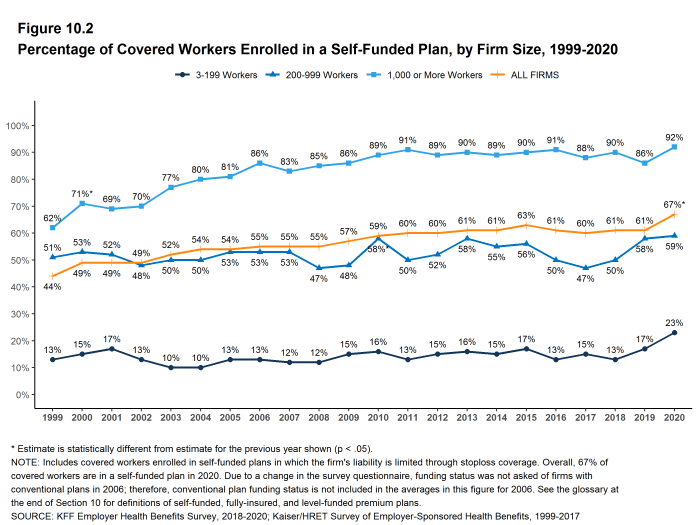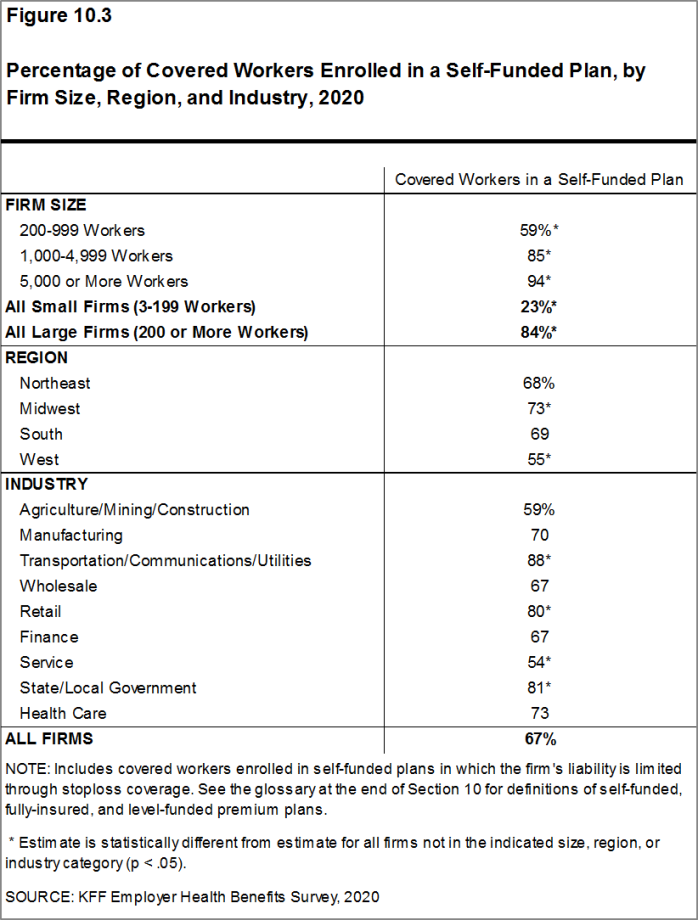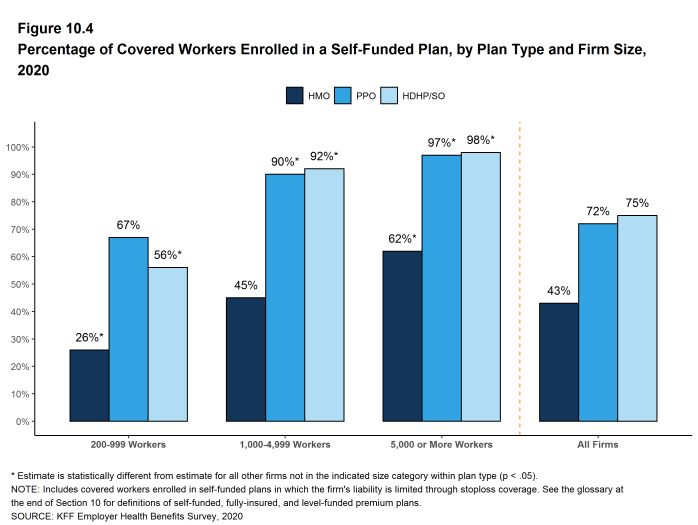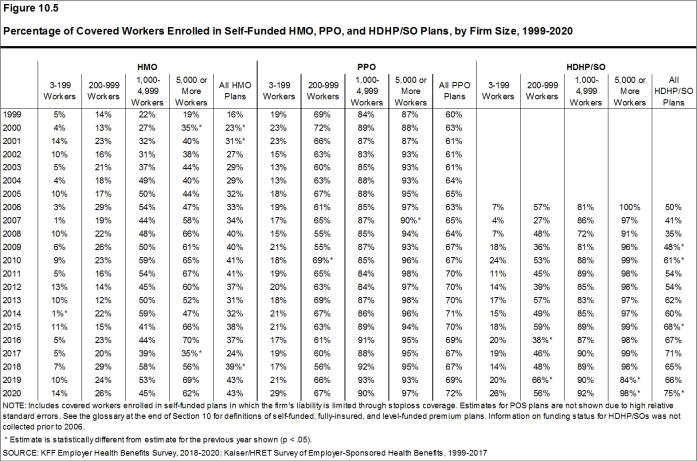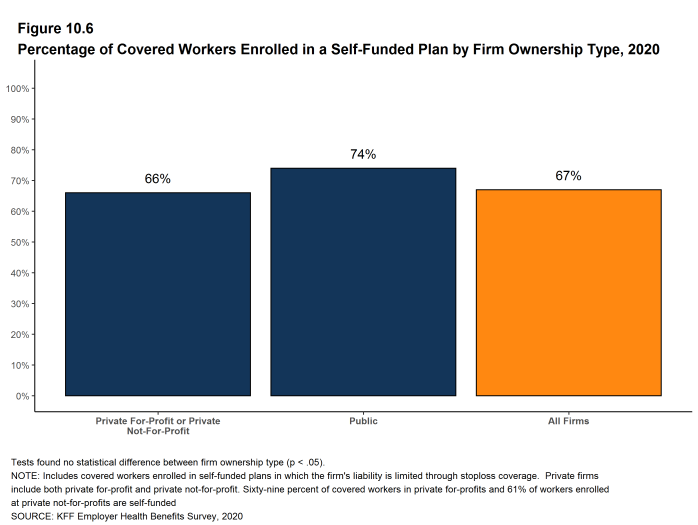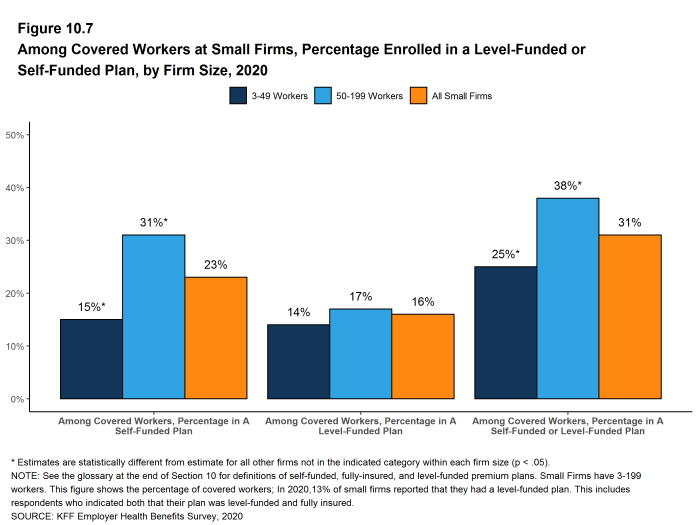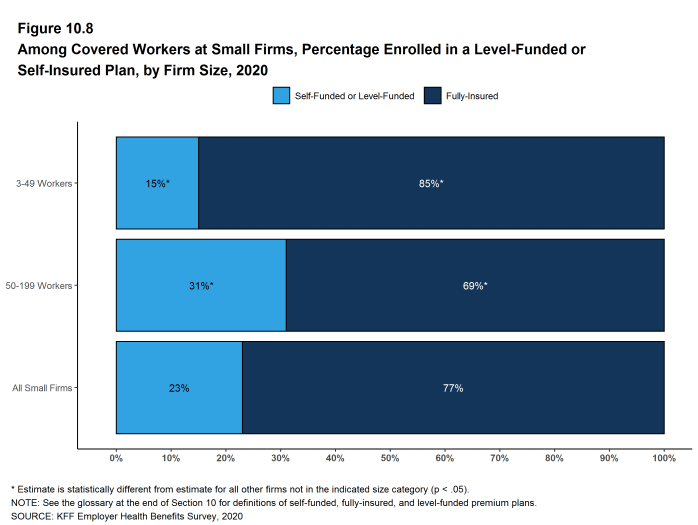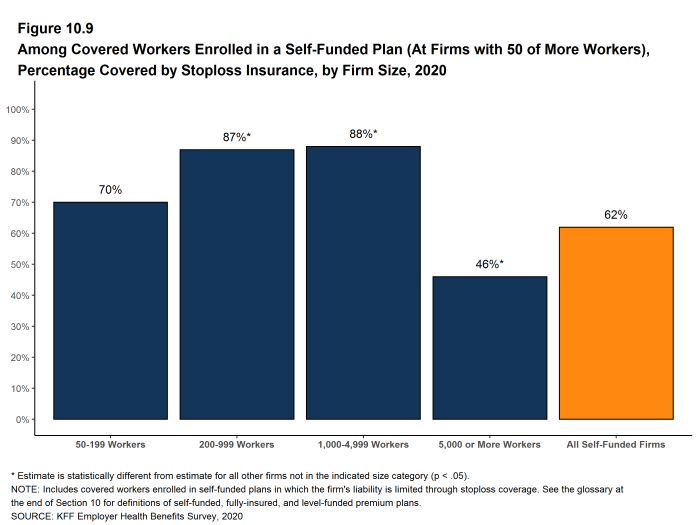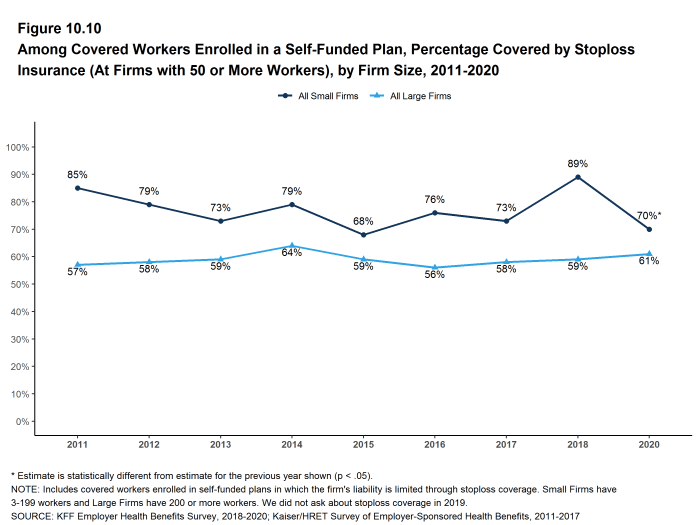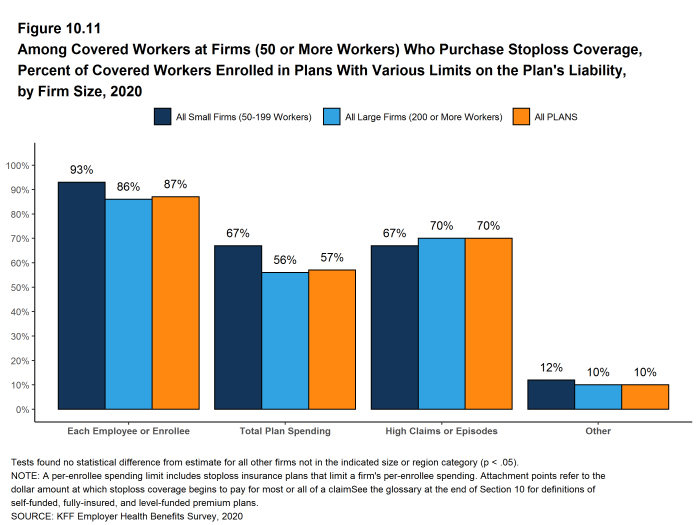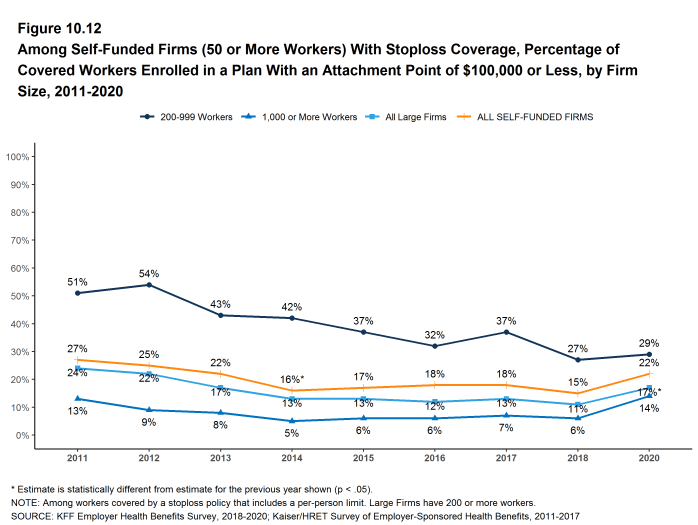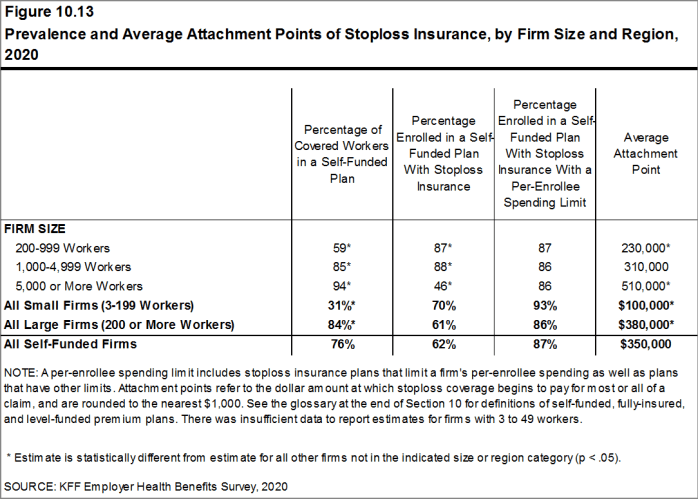2020 Employer Health Benefits Survey
Section 10: Plan Funding
Many firms, particularly larger firms, choose to pay for some or all of the health services of their workers directly from their own funds rather than by purchasing health insurance for them. This is called self-funding. Both public and private employers use self-funding to provide health benefits. Federal law (the Employee Retirement Income Security Act of 1974, or ERISA) exempts self-funded plans established by private employers (but not public employers) from most state insurance laws, including reserve requirements, mandated benefits, premium taxes, and many consumer protection regulations. Sixty-seven percent of covered workers are in a self-funded health plan in 2020. Self-funding is common among larger firms because they can spread the risk of costly claims over a large number of workers and dependents. Some employers which sponsor self-funded plans purchase stoploss coverage to limit their liabilities.
In recent years, a complex funding option, often called level-funding, has become more widely available to small employers. Level-funded arrangements are nominally self-funded options that package together a self-funded plan with extensive stoploss coverage that significantly reduces the risk retained by the employer. Sixteen percent of covered workers in small firms (3-199 workers) are in a level-funded plan.
SELF-FUNDED PLANS
- Sixty-seven percent of covered workers are in a plan that is self-funded, significantly higher than the percentage 61% last year [Figure 10.1] and [Figure 10.2].
- The percentage of covered workers enrolled in self-funded plans is similar to the percentage in five years ago (63%) but higher than the percentage (59%) ten years ago [Figure 10.2].
- As expected, covered workers in large firms are significantly more likely to be in a self-funded plan than covered workers in small firms (84% vs. 23%). The percentage of covered workers in self-funded plans generally increases as the number of workers in a firm increases. [Figure 10.1] and [Figure 10.3].
- The percentage of covered workers enrolled in self-funded plans is similar to the percentage in five years ago (63%) but higher than the percentage (59%) ten years ago [Figure 10.2].
Figure 10.3: Percentage of Covered Workers Enrolled in a Self-Funded Plan, by Firm Size, Region, and Industry, 2020
Figure 10.4: Percentage of Covered Workers Enrolled in a Self-Funded Plan, by Plan Type and Firm Size, 2020
Figure 10.5: Percentage of Covered Workers Enrolled in Self-Funded HMO, PPO, and HDHP/SO Plans, by Firm Size, 1999-2020
LEVEL-FUNDED PLANS
In the past few years, insurers have begun offering health plans that provide a nominally self-funded option for small or mid-sized employers that incorporates stoploss insurance with relatively low attachment points. Often, the insurer calculates an expected monthly expense for the employer, which includes a share of the estimated annual cost for benefits, premium for the stoploss protection, and an administrative fee. The employer pays this “level premium” amount, with the potential for some reconciliation between the employer and the insurer at the end of the year, if claims differ significantly from the estimated amount. These policies are sold as self-funded plans, so they generally are not subject to state requirements for insured plans and, for those sold to employers with fewer than 50 employees, are not subject to the rating and benefit standards in the ACA for small firms.
Due to the complexity of the funding (and regulatory status) of these plans, and because employers often pay a monthly amount that resembles a premium, respondents may be confused as to whether or not their health plan is self-funded or insured. We asked employers with fewer than 200 workers whether they have a level-funded plan.
- Thirteen percent of small firms offer a level-funded plan in 2020, similar to the percentage (7%) last year.
- Thirty-one percent of covered workers in small firms are in a plan that is either self-funded or level-funded in 2020, higher than the percentage (24%) last year [Figure 10.7].
Figure 10.7: Among Covered Workers at Small Firms, Percentage Enrolled in a Level-Funded or Self-Funded Plan, by Firm Size, 2020
STOPLOSS COVERAGE AND ATTACHMENT POINTS
Stoploss coverage may limit the amount of claims that must be paid by a plan sponsor for each worker or may limit the total amount the plan sponsor must pay for all claims over the plan year. At firms with 50 or more workers, sixty-two percent of covered workers in self-funded health plans are in plans that have stoploss insurance, similar to percentage the last time we asked the question in 2018 [Figure 10.9].
- The percentage of covered workers in self-funded plans with stoploss insurance (62%) is similar to the value when the survey first asked about stoploss insurance in 2011 (58%). [Figure 10.10].
- Among covered workers in self-funded plans with 50 or more workers that have stoploss, 87% are in plans where the stoploss insurance limits the amount the plan must spend on each worker or enrollee, 57% are in plans where the stoploss insurance limits the overall amount the plan must pay, 70% are in plans where the stoploss insurance limits the amounts that the plans must pay for high claims or episodes, and 10% are in plans where the stoploss insurance includes a different type of limit. Respondents were asked to choose all of the options that applied to their stoploss coverage [Figures 10.11]. Some plans have several limits applying to their plan. Starting in 2020, we restructured these questions and, while we believe the answers are similar to 2011 through 2018, changes in question wording may impact responses.
- Firms with 50 or more workers who have a per-enrollee stoploss coverage component were asked for the dollar amount where the stoploss coverage would start to pay for most or all of the claim (called an attachment point). The average attachment points for these firms are $100,000 for small firms (50-199) and $380,000 for large firms [Figure 10.13].
Figure 10.9: Among Covered Workers Enrolled in a Self-Funded Plan (At Firms With 50 of More Workers), Percentage Covered by Stoploss Insurance, by Firm Size, 2020
Figure 10.10: Among Covered Workers Enrolled in a Self-Funded Plan, Percentage Covered by Stoploss Insurance (At Firms With 50 or More Workers), by Firm Size, 2011-2020
Figure 10.11: Among Covered Workers at Firms (50 or More Workers) Who Purchase Stoploss Coverage, Percent of Covered Workers Enrolled in Plans With Various Limits On the Plan’s Liability, by Firm Size, 2020
Figure 10.12: Among Self-Funded Firms (50 or More Workers) With Stoploss Coverage, Percentage of Covered Workers Enrolled in a Plan With an Attachment Point of $100,000 or Less, by Firm Size, 2011-2020
Figure 10.13: Prevalence and Average Attachment Points of Stoploss Insurance, by Firm Size and Region, 2020
- Self-Funded Plan
- An insurance arrangement in which the employer assumes direct financial responsibility for the costs of enrollees’ medical claims. Employers sponsoring self-funded plans typically contract with a third-party administrator or insurer to provide administrative services for the self-funded plan. In some cases, the employer may buy stoploss coverage from an insurer to protect the employer against very large claims.
- Fully-Insured Plan
- An insurance arrangement in which the employer contracts with a health plan that assumes financial responsibility for the costs of enrollees’ medical claims.
- Level-Funded Plan
- An insurance arrangement in which the employer makes a set payment each month to an insurer or third party administrator which funds a reserve account for claims, administrative costs, and premiums for stop-loss coverage. When claims are lower than expected, surplus claims payments may be refunded at the end of the contract.
- Stoploss Coverage
- Stoploss coverage limits the amount that a plan sponsor has to pay in claims. Stoploss coverage may limit the amount of claims that must be paid for each employee or may limit the total amount the plan sponsor must pay for all claims over the plan year.
- Attachment Point
- Attachment points refer to the amount at which the insurer begins to pay its obligations for stoploss coverage, either because plan, individual or claim spending exceed a designated value.


